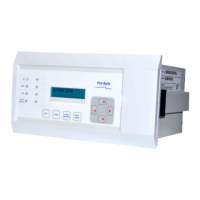2.5 Phase Overcurrent Protection (Motor Short Circuit Protection)
Phase current faults are faults where fault current flows between two or more phases of a three-phase
power system. The fault current may be between the phase conductors only or, between two or more
phase conductors and earth. There are three types of phase fault:
• Line to Line (accounting for approximately 8% of all faults)
• Line to Line to Earth (accounting for approximately 5% of all faults)
• Line to Line to Line (accounting for approximately 2% of all faults)
Although not as common as earth faults (single line to earth), phase faults are typically more severe.
Faults between phases seldom occur because of the relatively large amount of insulation between
phase windings. As the stator windings are completely enclosed in earthed metal most faults involve
earth, which would then operate the earth fault protection. However, a fast operating overcurrent
element is often employed to protect against phase faults occurring at the motor terminals; such as
terminal flashovers.
2.5.1 Phase Overcurrent Protection Implementation
Phase Overcurrent Protection is implemented in the OVERCURRENT column of the relevant settings
group.
The product provides three stages of three-phase overcurrent protection with independent time delay
characteristics. All settings apply to all three phases but are independent for each of the three stages.
Stages 1, 2 and 3 provide a choice of operate and reset characteristics, where you can select
between:
• A range of standard IDMT (Inverse Definite Minimum Time) curves
• DT (Definite Time)
This is achieved using the cells
• I>(n) Function for the overcurrent operate characteristic
• I>(n) Reset Char for the overcurrent reset characteristic
where (n) is the number of the stage.
The IDMT-capable stages, (1, 2 and 3) also provide a Timer Hold facility.This is configured using the
cells I>(n) tRESET, where (n) is the number of the stage. Timer Hold facility is applicable for both IEC
and IEEE curves. IEEE & US curves have IDMT reset curve option in addition to DT Phase
Overcurrent protection logic.
Phase Overcurrent modules are level detectors that detect when the current magnitude exceeds a set
threshold. When this happens, the Phase Overcurrent module in question issues a signal to produce
the Start signal. This Start signal is applied to the IDMT/DT timer module. It is also made available
directly to the user for use in the logic functions.
There are three Phase Overcurrent Modules, one for each phase. The three Start signals from each
of these phases and common Start signal for each stage of phase overcurrent function is available for
customer use.
The outputs of the IDMT/DT timer modules are the trip signals which are used to drive the tripping
output relay. The three Trip signals from each of the phases and common Trip signal for each stage
of phase overcurrent function is available for customer use.
The Phase overcurrent trip signal can be blocked by:
• The Second Harmonic blocking function which is for all three phases. The blocking is
activated by setting the I>(n) 2H Blocking cell to ‘Enabled’, where (n) is the number of the
stage.

